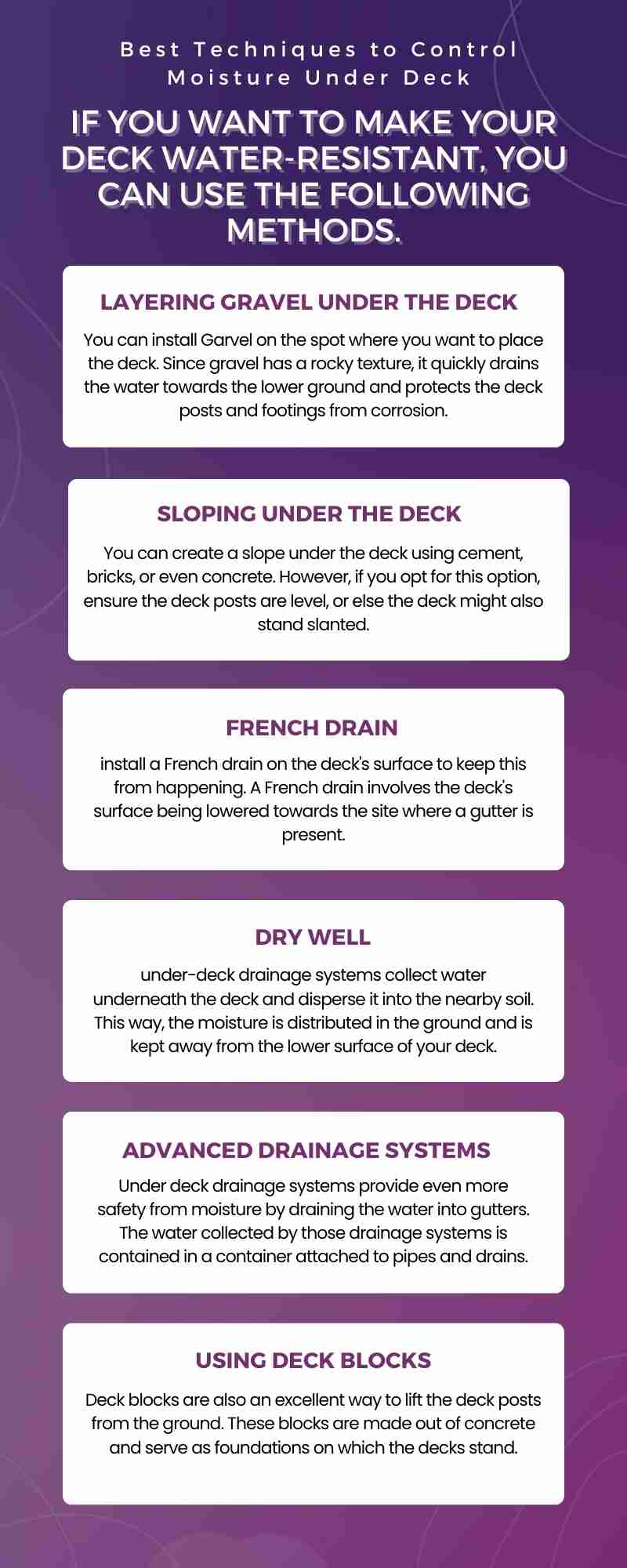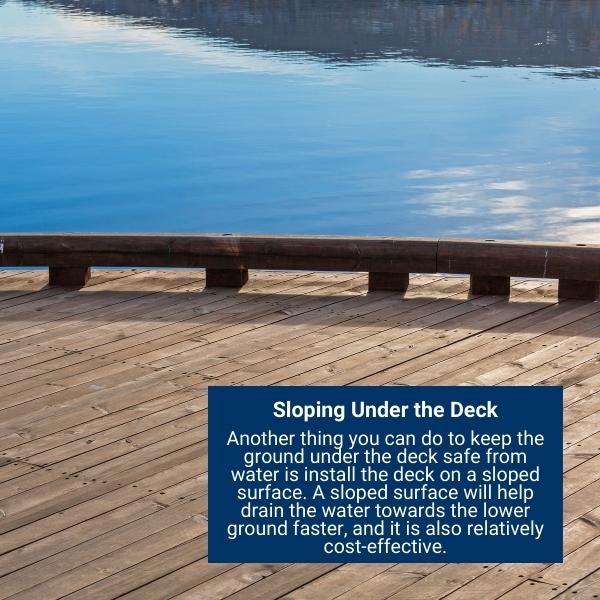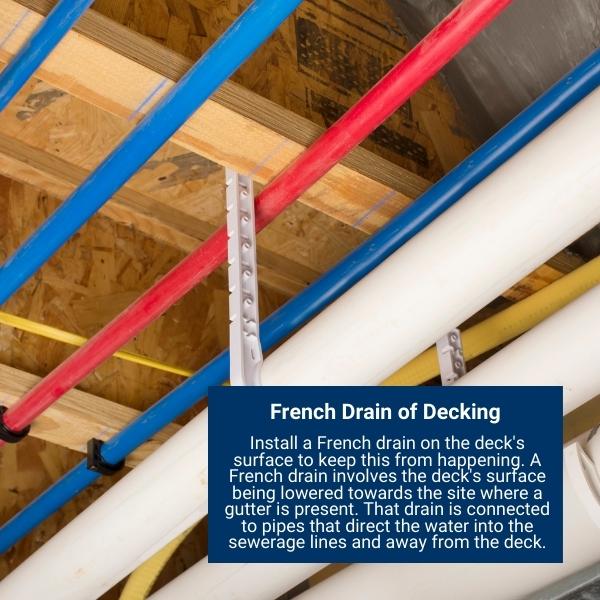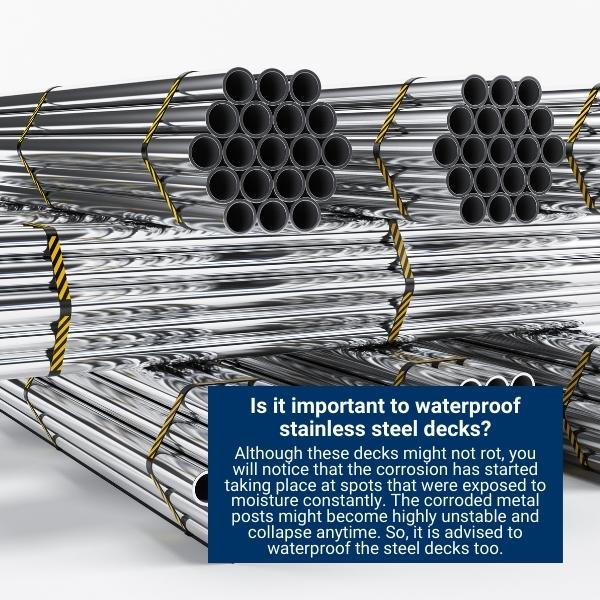Everybody wants their deck to last for at least 10-15 years. However, some factors might significantly reduce the deck’s lifespan and cause it to rot before time. One of the most dangerous factors for your deck is moisture, so you might want to keep all the water away from the deck. This quest might leave you wondering what to put under the deck for moisture?
You can control the moisture under the deck using various ways. First, you need to ensure your deck has an effective drainage system. Measures like building the deck on gravel instead of soil also quickly drain the water. You can also use deck blocks, rain membranes, dry well, etc., to help you stop the moisture from accumulating around the deck.
In this article, you’ll learn some proven ways that can help save your deck from rotting due to the excess moisture. So, continue reading to learn the best ways to waterproof your deck!
Why Is It Important To Control Moisture Under The Deck?
Some excellent ways and materials can help you save your deck from moisture.
If you want your deck moisture-free, you need to ensure it has a proper drainage system. If you don’t arrange an efficient drainage system for the deck, the water will keep accumulating around the deck.

The moisture might cause the wood used in deck formation to shrink and swell significantly. This expansion and contraction of the deck can weaken and damage the wood. In some cases, the decking might also bend, twist or split.
Moisture surrounding the deck also attracts unwanted pests like termites. Once these pests have made their way towards your deck, removing them can get very hard. The termites feed on the wood and weaken its foundation.
It is also important to mount the deck on a surface that doesn’t allow pooling. For this purpose, people prefer installing decks on gravel instead of regular soil/sand. Gravel quickly drains the water into the soil below and minimizes the water exposure for extended periods.
You can also incorporate waterproof flanges, dry well, deck blocks, deck membrane, etc., to prevent pooling and moisture near the deck.
Best Techniques To Control Moisture Under Deck
If you want to make your deck water-resistant, you can use the following methods.

1. Layering Gravel Under The Deck
A great way to waterproof the deck is to build it on land that doesn’t allow the water to collect around/under the deck. For this purpose, you can install Garvel on the spot where you want to place the deck. Since gravel has a rocky texture, it quickly drains the water towards the lower ground and protects the deck posts and footings from corrosion.
Grading the area under the deck also helps stop the weed formation. Since weeds and plants need soil to grow, installing a layer of gravel will also diminish this issue.
2. Sloping Under The Deck
Another thing you can do to keep the ground under the deck safe from water is install the deck on a sloped surface. A sloped surface will help drain the water towards the lower ground faster, and it is also relatively cost-effective.

You can create a slope under the deck using cement, bricks, or even concrete. However, if you opt for this option, ensure the deck posts are level, or else the deck might also stand slanted.
3. French Drain
Wood might absorb the water that accumulates on the deck surface. The water absorbed by the surface gets transmitted into the wooden joists and base of the deck. It might cause the sheets to expand vigorously. When this happens, the deck sheet’s alignment with the base gets damaged.

It is recommended to install a French drain on the deck’s surface to keep this from happening. A French drain involves the deck’s surface being lowered towards the site where a gutter is present. That drain is connected to pipes that direct the water into the sewerage lines and away from the deck.
Also Read: Deck VS Patio: Differences, Costs, Pros and Cons
4. Dry Well
A well-working drainage system is crucial to enhancing the deck’s lifespan. There are several under-deck drainage systems available. These under-deck drainage systems collect water underneath the deck and disperse it into the nearby soil. This way, the moisture is distributed in the ground and is kept away from the lower surface of your deck.
5. Advanced Drainage Systems/Deck Membranes
Some under deck drainage systems provide even more safety from moisture by draining the water into gutters. The water collected by those drainage systems is contained in a container attached to pipes and drains. These systems transmit the water from the lines to the gutter. This way, the water is quickly flushed into the connected drains.
6. Using Deck Blocks
Deck blocks are also an excellent way to lift the deck posts from the ground. These blocks are made out of concrete and serve as foundations on which the decks stand. Deck blocks increase the deck’s level. They also cut off the post’s contact with the ground. As a result, the water gathered around the deck cannot reach the deck posts and cause rotting.
If you live in an area where you experience a lot of rain, installing a deck using these blocks and a drainage system might prove a lifesaver.
Is It Important To Waterproof Stainless Steel Decks?
Stainless steel decks are a much better option for building a deck in places with higher rainfalls. However, it doesn’t mean that the stainless steel decks do not need protection from moisture.

Although these decks might not rot, you will notice that the corrosion has started taking place at spots that were exposed to moisture constantly. The corroded metal posts might become highly unstable and collapse anytime. So, it is advised to waterproof the steel decks too.
Conclusion
There are several ways to waterproof a deck and save it from moisture. You can use any of the methods mentioned above to channel the water away from the deck. However, I’d recommend you use a combination of these methods instead of just one to direct the water away from the deck seamlessly. These methods are also effortless and cost-effective so that you can do them yourself. However, if you don’t know anything about building decks, I’d recommend you hire a professional who can do the work for you.
Also Read: How Can You Build a Deck Without Concrete? Step by Step Guide

